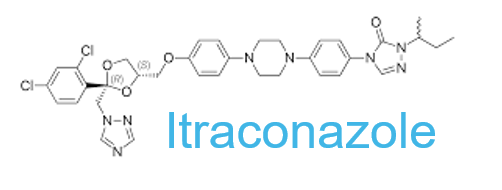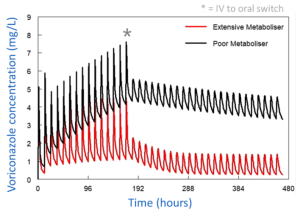
Ask an ID pharmacist at your hospital for advice about your local TDM policy and how to order the test, or contact the Mycology Reference Centre Manchester about submitting samples.

Invasive infections |
Chronic infections |
| Inpatient setting = easier to time blood draws and monitor toxicity | Outpatient setting = need to co-ordinate blood samples with GPs and postal service |
| Urgent = treatment may need to be started before all test results are available; loading dose may be needed | Long-term treatment = higher cost and greater chance of toxicity or resistance to develop |
| May have diarrhoea or mucositis that can affect absorption | Older patients are more likely to be taking PPIs |
Azole antifungals

- Target level: 1-2 mg/L (HPLC)
- GPs can prescribe itraconazole
- Read the SmPC
Itraconazole is relatively insoluble and ITS absorption is pH-sensitive. Bioavailability is reduced by antacids/PPIs, but can be improved by taking with an acidic drink (e.g. cola, orange juice).
An oral solution is available but be aware of additional side effects as it contains cyclodextrin.
Some laboratories may use a bioassay form of the test that measures both itraconazole and ITS metabolite hydroxy-itraconazole, in which case a higher target range will be used (5-17 mg/L)
- Target level: 2-5 mg/L
- Trough blood levels should be measured
- GPs cannot prescribe voriconazole
- Read the SmPC
Voriconazole-induced photosensitivity can be problematic even for patients with minimal sun exposure, so SPF 50 sunscreen is recommended while on treatment. Direct patients to this article at Aspergillosis.org for more tips on managing this side effect
Voriconazole levels can vary widely due to differences in metabolism. Patients with CYP2C19 slow-metaboliser variants may have up to 5x as much in their blood.

Find out more about how to carry out and interpret TDM of azoles in these webinars produced by LIFE Worldwide:
